In the last update I have seen characters with nomad armor in destroyed villages. This is Nomads or Hungarians?
Some elements of the weapons doubtful.
They are cumans (kun) settled on the hungarian plains during and after the mongolian invasion in the mid-XIII. century.
This is not Cumans, judging from the pictures. Too much alien arms and clothes.
а) Funny pants.
 And why all the helmets have a sharp top.
And why all the helmets have a sharp top.b) It is the Hungarian coat - but it’s a very different time:
http://cdn3.iranytv.hu/sites/iranytv.hu/files/styles/article_700/public/cikk-kepek/20140930/252javitott04kicsi-eli-alakulat-egyedulallo-honfoglalas-kori-kiallitas-miskolcon-sok-keppel-tue-30.jpg?itok=3IYrjqTo
Why is not this type?
http://img41.imageshack.us/img41/9568/kaftan1k.jpg
c) Yushman - also a very different time. During this period, they looked different.
http://swordmaster.org/2013/01/17/dospeh-behterec-iz-bartymskogo-i-selischa.html
Why rich warriors in armor walking worst shod?
d) This type of armor is archaic in 15th - it is better to replace it with chain mail.
e) Where is the bow and arrow? Why not saber?
a) Yushman - see above. Late shield - not suitable in time. Incorrect helmet.
b) Late shield - not suitable in time. Incorrect helmet. The central metal plate on his chest is not needed.
c) Two armor is much - better to leave a chain mail. Incorrect helmet. Sabre - do not use Shamshir 17th. There are many interesting alternatives that can be used.
If necessary, I can provide a lot of useful information about the weapons and clothing of the nomads of this era.
Mail-plate armor 14-15th
-
ПАСТУШЕНКО И. Ю. ДОСПЕХ-БЕХТЕРЕЦ ИЗ БАРТЫМСКОГО I СЕЛИЩА // ВЕСТНИК УДМУРТСКОГО УНИВЕРСИТЕТА. Выпуск № 5-3 / 2010
http://swordmaster.org/2013/01/17/dospeh-behterec-iz-bartymskogo-i-selischa.html
http://cyberleninka.ru/article/n/dospeh-behterets-iz-bartymskogo-i-selischa
-
ст. Усть-Лабенской.
Кулешов Ю. А. О позднем защитном вооружении народов Северного Кавказа // Военная археология. Сборник материалов семинара при ГИМ. Вып. 1. 2008. — С. 94-98. - http://www.kitabhona.org.ua/libwar_armor/kuleshov.html
Горелик. М.В. Монголо-татарское вооружение второй половины XIV - начала XV вв. // Куликовская битва в истории и культуре нашей Родины. М., 1983. - http://www.kitabhona.org.ua/libwar_armor/gorelikmongolarmor.html
Чхаидзе В.Н. Средневековые кочевнические погребения из раскопок Н.И. Веселовского в степном Прикубанье (ст. Ладожская и пос. Праздничный) // МИА Северного Кавказа. Вып. 11. — Армавир, 2010. - https://www.academia.edu/5033040/Chkhaidze_V._Burials_of_medieval_nomads_from_N._I._Veselovsky_excavation_in_steppes_Kuban_region
М.Горелик. Черкесские воины Золотой Орды (по археологическим данным). // Вестник Института гумманитарных иследований правительства КБР и КБНЦ РАН. Вып.15. Кабардино-Балкария, Нальчик, 2008. С.158-189.
http://www.kitabhona.org.ua/libwar_armor/kuleshov/r4.jpg http://www.kitabhona.org.ua/libwar_armor/gorelikmongolarmor/01.jpg
Бобров Л. А., Худяков Ю. С. Защитное вооружение среднеазиатского воина эпохи позднего средневековья // Военное дело
номадов Северной и Центральной Азии. Новосибирск: Новосибирский Государственный университет, 2002 . С. 106 – 168. - http://www.kitabhona.org.ua/libwar_armor/bobrovsa.html
http://www.kitabhona.org.ua/libwar_armor/bobrovsa/ris_3_l.jpg
- “Хамса” Навои, Багдад, 1465, б-ка “Индийского министерства” (Лондон).
- Миниатюры из альбома, Тебриз, сер. XV в., б-ка музея Топкапу (Стамбул).
- Миниатюры из альбома, Герат, кон. XV в., б-ка музея Метрополитен (Нью- Йорк).
- “Зафар-наме” Шараф-ал-Дина Йазди, Герат, 1495, б-ка Бостонского музея.
Shield
http://www.kitabhona.org.ua/forums/viewtopic.php?f=3&t=865
http://www.kitabhona.org.ua/forums/viewtopic.php?f=3&t=449
http://www.kitabhona.org.ua/forums/viewtopic.php?f=3&t=159
Metal shields are produced in countries with developed metallurgy. But the nomads was a constant shortage of metal (see below).
The best option for nomads (and often they did not have shields) - leather or wicker.
Osprey - Command 012 - Saladin
One of the rarest but also most damaged items to be found in the hoard of military material from a forgotten stairwell in the Citadel of Damascus are parts of a shield made of a spiral of cane bound with cotton. (Syrian National Museum Conservation Department, Damascus; author’s photograph)
Shields was used the warriors from the North Caucasus in the Golden Horde era.
http://www.tgorod.ru/contentimage/kuban/case7.jpg http://www.tforum.info/forum/uploads/post-2580-1233867327.jpg http://www.tforum.info/forum/uploads/post-2580-1233867375.jpg
Helmets
http://www.kitabhona.org.ua/forums/viewtopic.php?f=30&t=783
Helmet from Budapest 14-15th
http://mek.oszk.hu/09100/09175/html/8.html


Helmet from Krakow 14-15th
http://www.kitabhona.org.ua/forums/viewtopic.php?f=30&t=545
Hungary
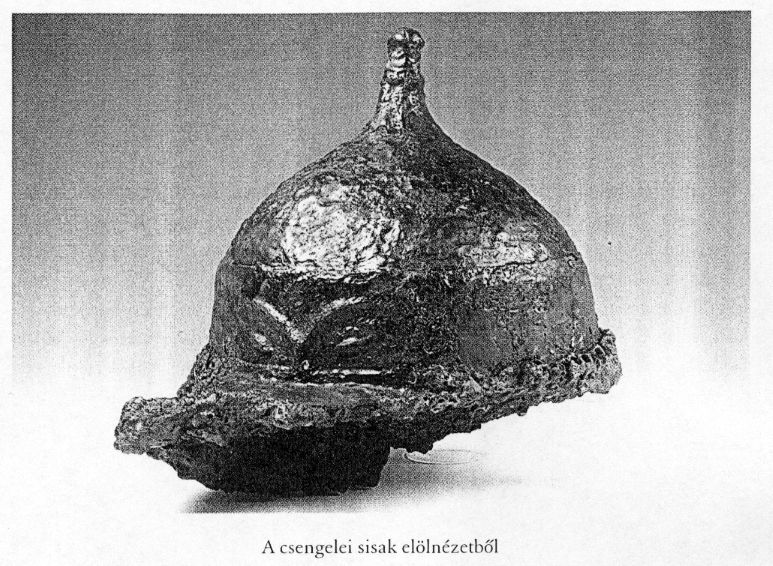
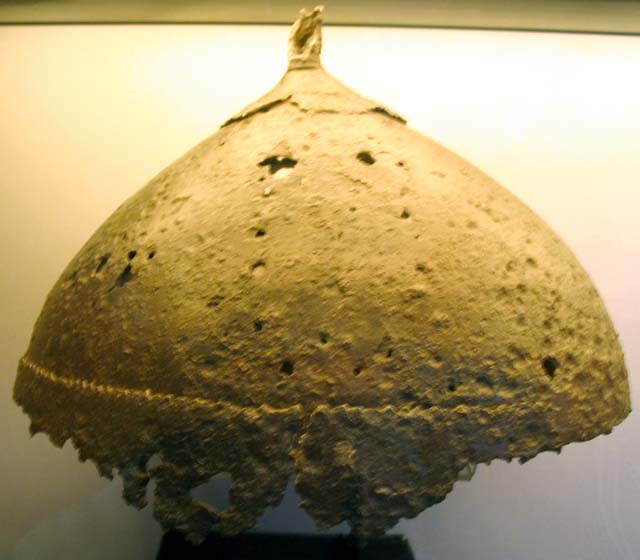
Bulgaria
http://www.csikimuzeum.ro/kiallitasok.php?l=ro&t=1&id=70&op=archiv
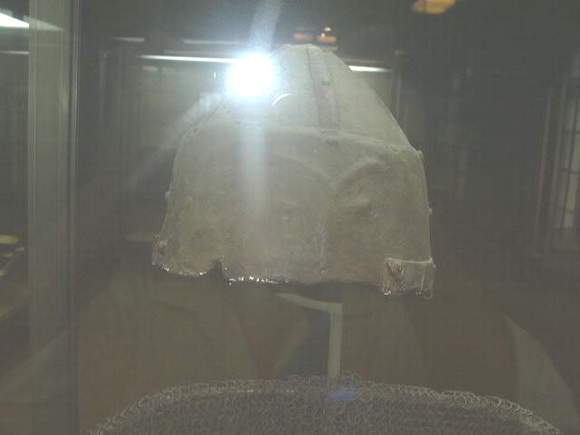
Ukraine
http://vk.com/club71661411?z=album-71661411_208408177
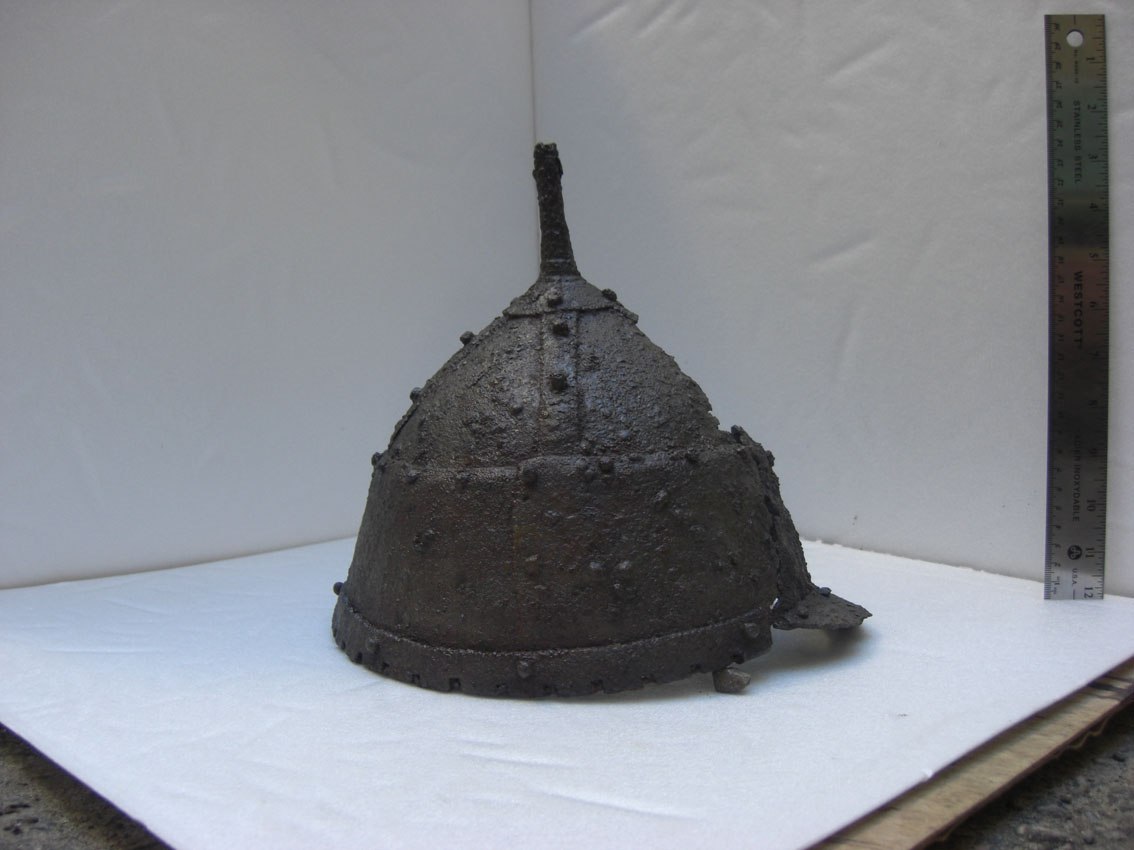
http://www.kitabhona.org.ua/gallery/muz_ukr/cher/index.html
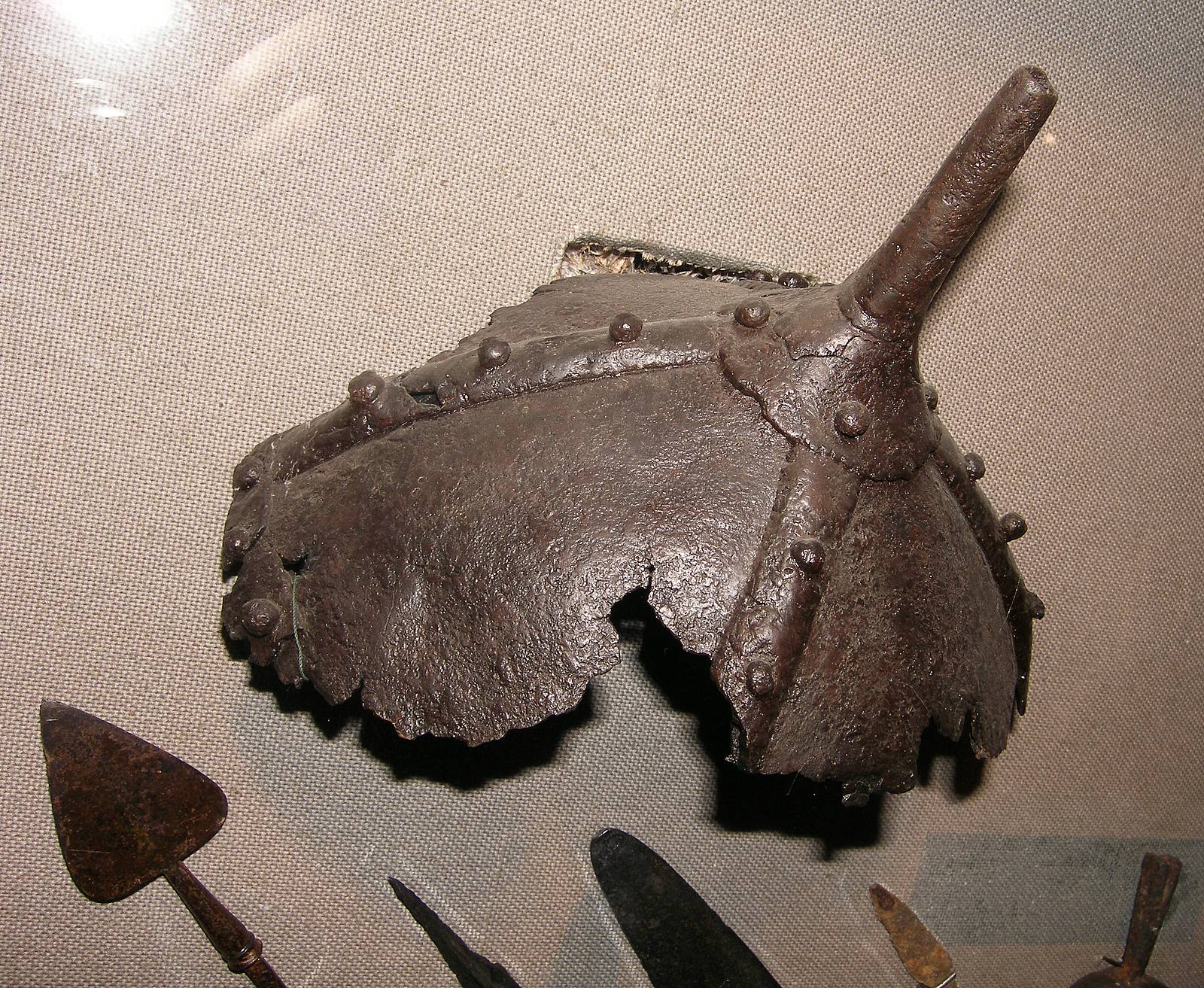
http://www.kitabhona.org.ua/forums/viewtopic.php?f=3&t=971
http://felicina.ru/vozvrashhyonnyie-sokrovishha-kubani/
http://felicina.ru/assets/images/products/86/7029.jpg
http://felicina.ru/assets/images/products/87/7036.jpg
articles
Жуков К. А. Русские сфероконические шлемы развитого средневековья // Воин № 18, 2005, стр. 18—27 - http://www.kitabhona.org.ua/libwar_armor/zhukovrusshlemy.html
О некоторых типах средневековых шлемов, с территории Северного Кавказа- http://swordmaster.org/2010/04/30/o-nekotoryx-tipax-srednevekovyx-shlemov-s.html
Монгольские шлемы с территории Алтая - http://swordmaster.org/2013/06/29/mongolskie-shlemy-s-territorii-altaya.html
Два предмета мамлюкского вооружения с территории Молдовы - http://swordmaster.org/2012/11/06/dva-predmeta-mamlyukskogo-vooruzheniya-s-territorii-moldovy.html
К истории шатровидных шлемов на Руси XIII-XV вв - http://swordmaster.org/2012/02/11/k-istorii-shatrovidnyh-shlemov-na-rusi-xiii-xv-vv.html
Курган Таганча, краткий отчет - http://swordmaster.org/2010/08/06/kurgan-tagancha-kratkij-otchet.html
Об одном типе шлемов из кочевнических погребений с территории Западного Дешт-и-Кыпчак / On one type of helmets from nomadic burials of the western Desht-i-Kipchak// Вестник ННГУ им. Н.И. Лобачевского. Т. 3. № 6. 2012. С. 62-70. https://www.academia.edu/5019693/Об_одном_типе_шлемов_из_кочевнических_погребений_с_территории_Западного_Дешт-и-Кыпчак_On_one_type_of_helmets_from_nomadic_burials_of_the_western_Desht-i-Kipchak_Вестник_ННГУ_им.%D0%9D.%D0%98.%D0%9B%D0%BE%D0%B1%D0%B0%D1%87%D0%B5%D0%B2%D1%81%D0%BA%D0%BE%D0%B3%D0%BE._%D0%A2._3._6.2012.%D0%A1._62-70
Helmet from Gorodets / Шлем из Городца // Батыр. Традиционная военная культура народов Евразии. № 4-5. 2014. С. 52-81.
https://www.academia.edu/11180487/Helmet_from_Gorodets_Шлем_из_Городца_Батыр.%D0%A2%D1%80%D0%B0%D0%B4%D0%B8%D1%86%D0%B8%D0%BE%D0%BD%D0%BD%D0%B0%D1%8F%D0%B2%D0%BE%D0%B5%D0%BD%D0%BD%D0%B0%D1%8F_%D0%BA%D1%83%D0%BB%D1%8C%D1%82%D1%83%D1%80%D0%B0_%D0%BD%D0%B0%D1%80%D0%BE%D0%B4%D0%BE%D0%B2_%D0%95%D0%B2%D1%80%D0%B0%D0%B7%D0%B8%D0%B8._4-5.2014.%D0%A1._52-81
Статьи И.А. Дружинина, В.Н. Чхаидзе
В.Н. Чхаидзе, И.А. Дружинина. Тяжеловооруженные золотоордынские воины Восточного Приазовья
Погребение кочевника XIII – 1-й пол. XIV вв. у села Лосево в степном Прикубанье (В.Н. Чхаидзе, И.А. Дружинина) // Степи Европы в эпоху средневековья. Том 8. Золотоордынское время. Донецк, 2010
https://www.academia.edu/5033088/Chkhaidze_V._Drujinina_I.Burial_of_the_nomad_of_13th-_first_half_of_14th_century_near_Losevo_village_in_steppes_of_Kuban_region
Чхаидзе В.Н., Дружинина И.А. (г. Москва) Средневековое кочевническое погребение из Калиновского курганного могильника в Ставропольском крае
В.Е. Нарожный, Е.И. Нарожный Погребение № 67 Келийского могильника (Горная Ингушетия) // Поволжская археология. №2 2012
http://archaeologie.pro/2012_2_pogrebenie-67.html
"Iran" helmet 14-15th
http://www.kitabhona.org.ua/forums/viewtopic.php?f=30&t=771 + https://picasaweb.google.com/113650598740985256040/HelmIran01?authkey=Gv1sRgCPyru97V5dDsMw
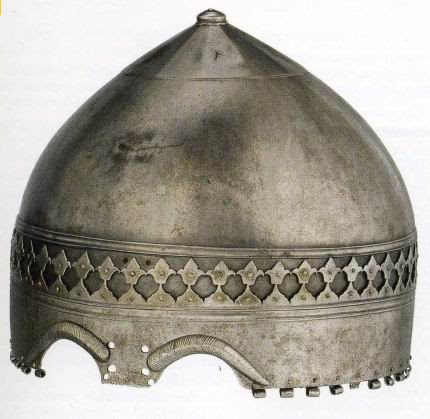

Mamuka Tsurtsumia The Helmet from the Wawel Royal Castle Museum and its Place in the evolution of Oriental helmet // Acta Militaria Mediaevalia, tom VII, red. Piotr N. Kotowicz, Kraków – Rzeszów – Sanok 2011 r., ISSN 1895-4103.
Central Asia
http://www.kitabhona.org.ua/forums/viewtopic.php?f=30&t=768
http://www.bonhams.com/auctions/21720/lot/158/
http://images1.bonhams.com/image?src=Images/live/2014-03/06/8914095-10-2.jpg&width=640&height=480&autosizefit=1
Helmets with a mask.
Description and links to watch in the link - http://www.kitabhona.org.ua/forums/viewtopic.php?f=3&t=4
http://www.kitabhona.org.ua/libwar_armor/lichina.html
http://www.kitabhona.org.ua/libwar_armor/kuleshov.html
Маска найденная в комплексе предметов вооружения XIXв. близ аула Итум-Кале в Аргунском ущелье Чеченской Республики.
Маска найденная в распаханном позднекочевническом кургане близ села Ротмистровка Каневского района Киевской губернии.
Маска из разрушенного позднекочевнического погребения близ деревни Куйбышево Волновахского района Донецкой области Украины

Маска из коллекции Государственного Объединенного Музея Республики Татарстан
Маска из кургана у села Липовцы
Маска из кургана у села Ковали
Фрагмент маски из Херсонеса

Маска из Серенска
Фрагмент маски из Изяславля
маска из собрания Военно-инженерного музея артиллерии в войск связи в Питере, 15 в., Восточная Анатолия.
Reconstruction
http://www.kitabhona.org.ua/forums/viewtopic.php?f=10&t=827
http://www.kitabhona.org.ua/forums/viewtopic.php?f=10&t=876
http://img444.imageshack.us/img444/2268/31450825403275797392911.jpg
http://img40.imageshack.us/img40/2945/39231543293210008399328.jpg
http://www.kitabhona.org.ua/forums/viewtopic.php?f=10&t=842
http://img833.imageshack.us/img833/1848/39156742199961451057513.jpg
http://www.kitabhona.org.ua/forums/viewtopic.php?f=10&t=849
http://img33.imageshack.us/img33/4856/20882742983151706071853.jpg
http://www.kitabhona.org.ua/forums/viewtopic.php?f=10&t=852
http://img16.imageshack.us/img16/9432/p1160983m.jpg
http://www.kitabhona.org.ua/forums/viewtopic.php?f=10&t=851
http://img341.imageshack.us/img341/8995/p1160386m.jpg
http://www.kitabhona.org.ua/forums/viewtopic.php?f=10&t=861
http://img42.imageshack.us/img42/2563/p1160634u.jpg
Rekonstrukcja maski iz Rotmistrovki v variante z muzei
http://img827.imageshack.us/img827/1037/p1160320.jpg
http://www.kitabhona.org.ua/forums/viewtopic.php?f=10&t=1157

These helmets here does not seem much different from those in the game
What is “nomads”? Cumans were settled for some time within Hungary already. Hungary may have not been the most progressive part of Europe, but metallurgy was at home there for quite some time already.
Really? Citadel of Damascus being used as a source as regards Cuman soldiers from Hungary?
In the game a lot of mistakes.
http://forum.kingdomcomerpg.com/uploads/default/original/2X/d/df749e8f5151ab08c6e07b86c8b99fbdba2a637d.jpg
a) Errors in geometry. The helmet should look like one piece without the vertical bars. They were gilded (often).
b) It is 10-11th - another nation, another era. And why he has a mask?
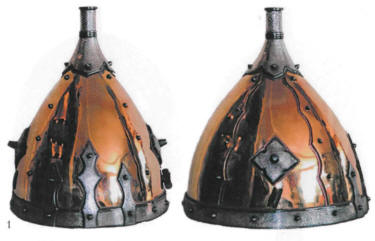
c) The helmet should look like one piece without without segments. Incorrect turning hinge masks. It is foolish to run with lowered mask. Outside of combat, it is better to keep open or take off (but it is impossible to do in the game).
The problem is that I do not see a simple helmet. In the game there are more advanced and expensive helmets. I was curious to see all the variations of the “eastern” helmets in the game.
There is also the problem of the number of nomads who could / should wear armor.
This thread.
I like it.
Central/Eastern European history has never been my focus but it’s always nice to see some of it.
What is “nomads”?
Then who are they and why are they dressed and armed with that? The Hungarians, the Cumans came to Hungary 180-150 years ago, the warriors of the Golden Horde? Depending on whether who this fraction, we can talk about the details of clothes and weapons.
Андраш Палоци Хорват (Pálóczi Horváth András): Восточные народы в средневековой Венгрии. Печенеги, узы, половцы, ясы https://www.academia.edu/9840722/Андраш_Палоци_Хорват_Pálóczi_Horváth_András_Восточные_народы_в_средневековой_Венгрии.%D0%9F%D0%B5%D1%87%D0%B5%D0%BD%D0%B5%D0%B3%D0%B8%D1%83%D0%B7%D1%8B_%D0%BF%D0%BE%D0%BB%D0%BE%D0%B2%D1%86%D1%8B_%D1%8F%D1%81%D1%8B
Hungary may have not been the most progressive part of Europe, but metallurgy was at home there for quite some time already.
Yes, but here it is more about the traditions of warfare Hungary / Cumans / Tatars. The tactics of the nomads era of the Golden Horde did not require the mandatory presence of shields the majority of warrior.
Кулешов Ю.А. «Монгольская латная конница» – историческая реальность или научная спекуляция? // Золотоордынская цивилизация. Сборник статей. Выпуск 5. – Казань: Институт истории им. Ш.Марджани АН РТ, 2012. – С. 153-180. - http://millitarch.ru/wp-content/uploads/2013/09/Кулешов-Латн.конница6.pdf
Metal shields are known in Central Asia, Iran and India - but not in Europe. Indo-Persian shields 18-19 century in the game for Eastern Europe 14-15 century, is too much.
Really?
You speak as if you have a information about shields of nomads in Eastern Europe 10-15 century. Do you have it? You have information about shield construction, shape, material?
I am looking for information from many sources, and fragments of shield from Syria show far as a wicker shields are old. This is an illustration of technology widely known in 16-18 centuries on an example shields-kalkans.
Interesting material about production and export of weapons in the Golden Horde.
Кулешов Ю. А. Производство и импорт оружия как пути
формирования золотоордынского комплекса вооружений // Золотоордынская цивилизация. Выпуск 3. Казань: Изд. «Фэн» АН РТ, 2010. С. 73-97.
http://millitarch.ru/wp-content/uploads/2011/06/kuleshov_1.pdf
I quite forgot. It is known that the Mamluks exported to the Golden Horde weapons and armor. And Syria has belonged to the Mamelukes in 13-15 century.
http://millitarch.ru/wp-content/uploads/2011/06/kuleshov_1.pdf + http://swordmaster.org/2012/11/06/dva-predmeta-mamlyukskogo-vooruzheniya-s-territorii-moldovy.html + http://gladius.revistas.csic.es/index.php/gladius/article/viewArticle/40
Look, I am not saying you are wrong, however the way you communicate makes it feel like you are some spammer/troll than someone who knows what you are talking about. It is hard to have any discussion when you are just throwing a ton of links and very little coherent thought.
Also, although Cyril and Method did do most of their work in the Czech lands, we never really got to use Cyrillic alphabet, not in the 9th century and certainly not in the 21st. So whatever you are writing in Cyrillic alphabet, I doubt anyone can read that.
One of the recurring themes of debate on this forum is people coming in and saying that some depictions of 15th century Bohemia are incorrect because people used different style of armor in 15th century England, because people used different fighting styles in 15th century Italy, because society was different in 15th century Spain, etc. etc.
You have, among other, pointed out to the fact that Golden Horde era nomads did not use shields, that nomadic people were not good in metallurgy, and that in the Cidatel of Damascus a different style of armor may be found. Which may all be very well true, but has no weight as regards Cuman warriors that were for some 150 years settled and living within Hungary and who came in 1403 to ravage the Czech Crown lands as a part of Hungarian Habsburg Army. You need to bring in sources dealing especially with early 15th century Hungarian/Cuman army in order to disprove the way KCD portrays them.
Other language can really be a problem. But this theme poorly studied in the english articles. Links to the forum (http://www.kitabhona.org.ua/) - is the fastest way to indicate to the base of material. I write in Cyrillic but translated forum of Internet resources of the 21st century without problems. Links to articles help to those who wants to study the topic himself. I know a lot of them, they were going for a long time and I still have a lot of material for discussion of this topic. Several articles of my links has the form Internet pages - use Google Translator for Firefoh and no problems in the translation.
To translate easy to use Google translator or plug-ins:
https://translate.google.com.ua
https://addons.mozilla.org/UK/firefox/addon/google-translator-for-firefox/?src=userprofile
The Google documents have the ability to recognize the scanned text.
“Eastern faction” in the game is a big problem. The big problem - a large volume of material for discussion.
You have, among other, pointed out to the fact that Golden Horde era nomads did not use shields,
I wrote
The tactics of the nomads era of the Golden Horde did not require the mandatory presence of shields the majority of warrior.
and
Shields was used the warriors from the North Caucasus in the Golden Horde era.
Keyword “not require the mandatory presence” and “majority of warrior”. Light horsemen archers (such as in the army were in the majority) shield (close combat active attribute) is often not needed. As expensive armor. Archaeological excavations point to the small spread of shields in the Golden Horde. Exception - the North Caucasus. Shields are allowed the soldiers with a full set of weapons and armor, but light archers (which most), it is not mandatory.
On Syria, I repeat - example braided shield design. Live, really existing example of a shield.
You need to bring in sources dealing especially with early 15th century Hungarian/Cuman army in order to disprove the way KCD portrays them.
It is possible, but then they would lose many of armor and weapons. 
About archaeological finds belonging to Cumans in Hungary my knowledge not so much. There are several burial of the 13th century, individual items of weapons and armor. Some more information can be extracted from graphic sources. Begin better with them.
DRAGOŞ GH. NĂSTĂSOIU , Nouvelles représentations de la Légende de Saint Ladislasà Crăciunel et Chilieni - http://www.istoria-artei.ro/resources/files/RRHA_%202008.pdf
http://www.modvsvivendi.org/forum_1/viewtopic.php?f=31&t=935
14th
„Codeх Manesse”, Zurich, 1305-1330
http://www.manesse.de/manesse/img/073.jpg
The Cumanian abducting a girl from the wall-painting of the St Ladislaus legend (Kakaslomnic/Vel’ká Lomnica, Slovakia)
St Ladislaus is fighting with the Cumanian. A wall-painting of a Roman Catholic church from Kakaslomnic (Vel’ká Lomnica, Slovakia), 1300-1310
http://tarvos.imareal.oeaw.ac.at/server/images/7012819.JPG
http://tarvos.imareal.oeaw.ac.at/server/images/7012820.JPG
http://tarvos.imareal.oeaw.ac.at/server/images/7012821.JPG
http://tarvos.imareal.oeaw.ac.at/server/images/7012822.JPG
Cuman warrior shooting his arrow backwards in the representation of the St Ladislaus legend in Szepesmindszent (Bijacovce, Slovakia), 14th.
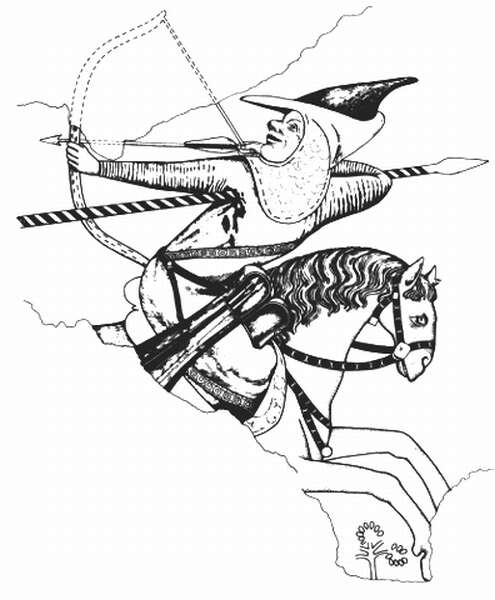
The middle and finishing scenes of the St Ladislaus legend. Gelence (Ghelinюa, Rumania), 1330.
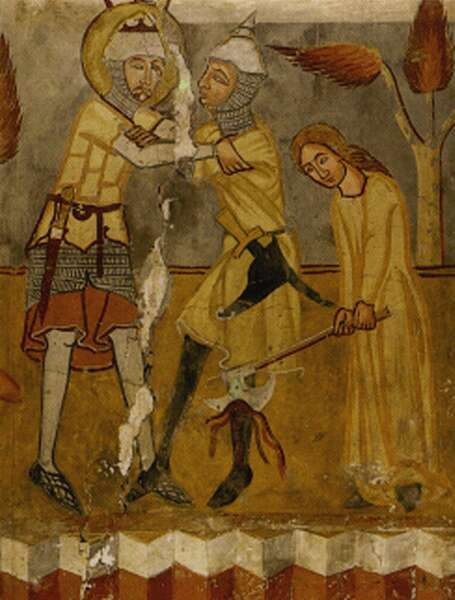
Homoródkarácsonyfalva / Craeciunel / Krötschendorf, Rumniya, 14th:
http://www.ezerdely.hu/pics/kepek/bg/ezerdely_udvarhelyszek_regio_homorodkaranyonyfalva_homorodkaranyonyfalva_unitarius_temploma_983261_197858_DSC_0066u.jpg

Prince Ladislaus’s fight with the Cumanian, who abducted a girl
Képes Krónika (Chronicon Pictum), 1342.
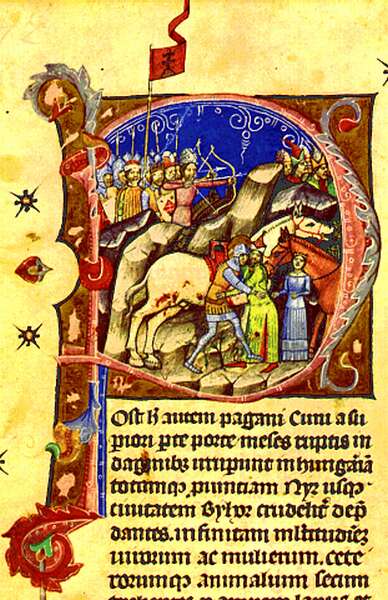
Hungarian king Ladislaus IV and his murderers. From a codex written in 1358
https://upload.wikimedia.org/wikipedia/commons/thumb/e/e3/Chronicon_Pictum_P129_IV.L%C3%A1szl%C3%B3%C3%A9s_gyilkosai.JPG/397px-Chronicon_Pictum_P129_IV.L%C3%A1szl%C3%B3%C3%A9s_gyilkosai.JPG
King St Ladislaus’s story with the Cumanian, Magyar Anjou Legendбrium, ок. oк. 1330.
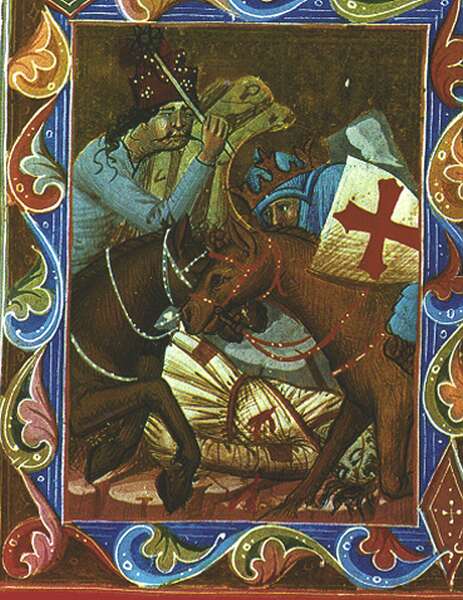
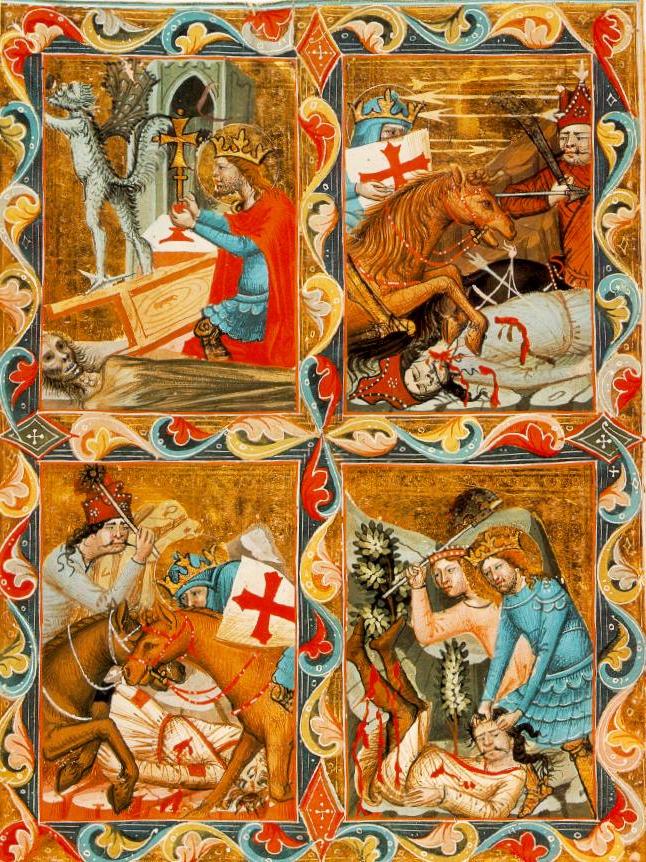
Ladislaus IV (the Cumanian), Képes Krónika (Chronicon Pictum), 1342.


Illuminated Chronicle; Chronicon Pictum; Képes Krónika

![]()
http://forum.kingdomcomerpg.com/uploads/default/3887/eab22e5e22d42dbc.jpg
http://forum.kingdomcomerpg.com/uploads/default/3888/0486bd90f128b11e.jpg
Bántornya (Turnisce), Slovenia, 1383.:

Türje, Hungary, 14th
http://upload.wikimedia.org/wikipedia/hu/b/bd/TÜRJE_5306_KT090620.jpg
Hungary,



http://www.kunszentmartontortenete.hu/kepek_hun/kun_harcos.jpg

http://www.britishmuseum.org/explore/highlights/highlight_objects/pd/a/albrecht_dürer,landscape.aspx
http://commons.wikimedia.org/wiki/File:Albrecht_Dürer-Landscape_with_the_Cannon%28NGA_1950.17.21%29.jpg
Albrecht Dürer, Landscape with a Cannon, an etching
Germany, signed and dated AD 1518
I know that this image is 100 years younger than the events of the game. But it is interesting to look at Cuman (?) As a part of the Hungarian embassy. Researchers believe that his clothes is very archaic. So, this picture can be useful.
From The myth of arrow quivers on the back
http://digi.ub.uni-heidelberg.de/diglit/cpg90/0155
Cod. Pal. germ. 90 Vitaspatrum, deutsch — Süddeutschland, 1477

Miniature by 74 years younger than the game. Also shown here is probably the Tatars. However, it is important to note the identity of a hat, hair and lack of armor. 



















